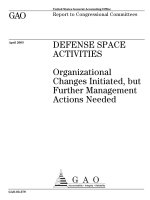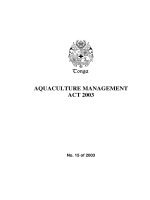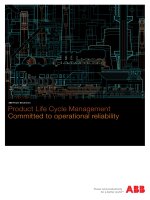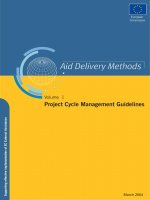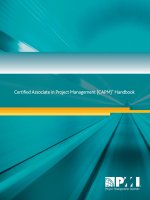Project Cycle Management Training Handbook pdf
Bạn đang xem bản rút gọn của tài liệu. Xem và tải ngay bản đầy đủ của tài liệu tại đây (537.55 KB, 79 trang )
EUROPEAN COMMISSION
JOINT RELEX SERVICE FOR THE MANAGEMENT OF COMMUNITY AID TO NON-MEMBER
COUNTRIES (SCR)
Resources, relations with the other institutions, evaluation, and information
Evaluation
Version 1.0
May 1999
P
P
r
r
o
o
j
j
e
e
c
c
t
t
C
C
y
y
c
c
l
l
e
e
M
M
a
a
n
n
a
a
g
g
e
e
m
m
e
e
n
n
t
t
T
T
r
r
a
a
i
i
n
n
i
i
n
n
g
g
H
H
a
a
n
n
d
d
b
b
o
o
o
o
k
k
Prepared by
ITAD Ltd. (Information Training and Agricultural Development),
Lion House, Ditchling Common Industrial Estate, Hassocks, West
Sussex, BN6 8SL, UK
Tel: +44 1444 248088 Fax: +44 1444 248763
Email: Website: www.itad.com
Programming
Financing
Identification
Formulation
Evaluation
Implementation
Project Cycle Management Handbook Training Action for Project Cycle Management
Project Cycle Management Handbook
Table of contents
CHAPTER 1 INTRODUCTION 1
1.1 PURPOSE OF THE HANDBOOK 1
1.2 QUALITY MANAGEMENT 2
1.3 CONTENTS 2
1.4 HOW TO USE THE HANDBOOK 4
CHAPTER 2: PROJECT CYCLE MANAGEMENT 6
2.1 THE PROJECT CYCLE 6
2.2 PROJECT CYCLE MANAGEMENT 9
2.3 PCM PLANNING AND MANAGEMENT TOOLS 13
2.4 SUMMARY 14
CHAPTER 3: THE LOGICAL FRAMEWORK APPROACH – A
PROJECT DESIGN AND ANALYSIS TOOL 15
3.1 INTRODUCTION 15
3.2 THE ANALYSIS PHASE 16
3.2.1 Problem Analysis 16
3.2.2 Analysis of Objectives 19
3.2.3 Strategy Analysis 20
3.3 THE PLANNING PHASE 21
3.3.1 The Logframe Matrix 21
3.3.2 Levels of Objectives 23
3.3.3 Assumptions 25
3.3.4 Factors Ensuring Sustainability 27
3.3.5 Objectively Verifiable Indicators (OVIs) 29
3.3.6 Sources of Verification (SOVs) 30
3.3.7 Means and Costs 31
3.3.8 The Logframe – An Example 32
3.4 SUMMARY 34
CHAPTER 4 USING THE LOGICAL FRAMEWORK TO DEVELOP
ACTIVITY AND RESOURCE SCHEDULES 36
4.1 ACTIVITY AND RESOURCE SCHEDULES 36
4.1.1 A Checklist for Preparing an Activity Schedule 37
4.1.2 Presenting an Activity Schedule 39
4.2 PREPARING RESOURCE SCHEDULES 40
4.2.1 A Checklist for Specifying Means and Scheduling Costs 40
4.3 SUMMARY 42
CHAPTER 5 USING THE LFA TO ASSESS PROJECT PROPOSALS 43
5.1 INTRODUCTION 43
5.2 GUIDE FOR ASSESSMENT OF A PROJECT PROPOSAL 44
Instruction 1: Analyse problems & objectives 45
Instruction 2: Identify the intervention logic and assumptions 46
Instruction 3: Assess assumptions 48
Instruction 4: Assess sustainability 49
Instruction 5: Identify indicators 49
Instruction 6: Prepare Terms of Reference 50
5.3 THE QUALITY ASSESSMENT TOOL 51
5.4 SUMMARY 54
Project Cycle Management Handbook Training Action for Project Cycle Management
CHAPTER 6 MONITORING AND REPORTING 55
6.1 INTRODUCTION 55
6.2 DESIGNING A MONITORING SYSTEM 56
6.2.1 Analyse Project Objectives 57
6.2.2 Review Implementation Procedures 57
6.2.3 Review Indicators 58
6.2.4 Reporting 59
6.3 SUMMARY 62
CHAPTER 7 PROJECT REVIEW AND EVALUATION 63
7.1 INTRODUCTION 63
7.2 EVALUATION CRITERIA 63
7.3 LINKAGE TO THE LOGFRAME 64
7.3.1 Costs 64
7.3.2 Activities 65
7.3.3 Results 65
7.3.4 Project Purpose 66
7.3.5 Overall Objectives 66
7.4 OPPORTUNITIES FOR EVALUATION 67
7.5 SUMMARY 68
Index of Figures
Figure 1: Training Objectives 1
Figure 2: Improving Project Quality 3
Figure 4: Rationale for PCM 9
Figure 5: PCM Principles 11
Figure 6: The Integrated Approach 12
Figure 7: The Logical Framework Approach 15
Figure 8: A Problem Tree 18
Figure 9: Transforming Problems into Objectives 19
Figure 10: An Objective Tree 20
Figure 11: Strategy Selection 21
Figure 12: The Logframe Matrix 23
Figure 13: The Relationship between Results and Project Purpose 24
Figure 14: Transposing Objectives into the Logframe 25
Figure 15: Specifying Assumptions 26
Figure 16: The Role of Assumptions 27
Figure 17: The Assumptions Algorithm 27
Figure 18: Ensuring that OVIs are Specific 29
Figure 19: Indicators and Aid Management 30
Figure 20: The Relationship Between Cost and Complexity in the Collection of Data 31
Figure 21: An Example of a Completed Logframe 33
Figure 22: Activity and Resource Schedules 36
Figure 23: Example of an Activity Schedule 40
Figure 24: Example of a Resource Schedule 41
Figure 25: The Role of Terms of Reference in Project Preparation 44
Figure 26: Marking Problems & Objectives in a Project Proposal 45
Figure 27: Terms of reference for a Feasibility Study 51
Figure 28: The Quality Assessment Tool 52
Figure 29: How the Quality Assessment Tool works 53
Figure 30: Monitoring 55
Figure 31: Information Needs and Levels of Management 57
Figure 32: Evaluation 63
Figure 33: Linking Indicators to the Logframe 65
Project Cycle Management Training Handbook
1
Chapter 1 Introduction
This Chapter introduces the handbook, explaining its role as a
support to the PCM training programme, and providing an overview
of its contents.
1.1 Purpose of the Handbook
This handbook is intended as an accompaniment to the Project Cycle
Management training programme run by SCR Evaluation Unit for
RELEX services (DGs IA, IB and VIII) and the SCR. It also serves as
a post-course support to the application of techniques and approaches
learnt during training. The objectives of this handbook therefore
reflect those of the training programme itself, and in particular the
Basic and Advanced modules.
Figure 1: Training Objectives
Basic Training
By the end of the workshop, participants will
understand:
G the role of the project cycle, and key activities to
be undertaken at each stage
G the principles of Project Cycle Management &
the Logical Framework Approach (LFA)
G how to use the LFA to assess a project
document & identify information needs for a
feasibility study
G how to structure terms of reference for feasibility
studies
G the role of the logframe in project monitoring &
evaluation
G the importance of the integrated approach & the
PCM basic format
Advanced Training
By the end of the workshop, participants will
be able to:
G critically review the role of Financing Proposals
G assess the potential relevance, feasibility &
sustainability for a case study Financing
Proposal, & identify how to improve its quality
G understand the role & importance of indicators
for project preparation, implementation &
evaluation
G formulate indicators for a case study logframe
G link information needs to levels of management
within a progress reporting system
This handbook is aimed primarily at those of you attending PCM
seminars and workshops – which includes Commission staff from all
levels of management at headquarters and delegations; project
planners and managers from counterpart governments and agencies;
and consultants, project managers and others involved in the
implementation of RELEX projects.
Why another
handbook?
Target group
Project Cycle Management Training Handbook
2
Add your own notes here…
1.2 Quality Management
At field-level, project preparation, implementation and evaluation is
undertaken by consultants or partner governments and organisations.
The role of Commission staff is to manage the process of preparation,
implementation and evaluation. As process managers, you therefore
need tools and techniques which help you to support and control the
quality of outputs produced during the process – for example, to
identify information needs for preparatory studies; to plan appraisal
missions; and to check the quality of project proposals.
Figure 2 gives an overview of the tools that are already available in
the training programme, and shows how they can be used to manage
quality. All of the tools mentioned are covered in more detail later on
in the handbook.
1.3 Contents
The tools and techniques outlined in the handbook are designed to
assist you in preparing and managing your projects. :
1 Chapter 2 introduces you to the project cycle, describing its
phases and explaining its role in aid management. It presents
an overview of Project Cycle Management.
1 Chapter 3 introduces you to the Logical Framework
Approach (LFA), explaining its role in project design with a
simple project example. It explains how sustainability factors
can influence a project’s chances for success, and indicates
the range of tools that are available to you to take account of
these factors.
1 Chapter 4 explains how you can use the logframe matrix to
develop objective-oriented workplans and budgets, and
presents a step-by-step approach to the preparation of activity
and resource schedules.
Process
management
Project Cycle Management Training Handbook
3
Figure 2: Improving Project Quality
Managing the Quality of
Project Design
Project
Proposal
Identify
Information
Needs
Financing
Proposal
Formulate questions
concerning project
relevance, feasibility
& sustainability
Ensure that information
collection & analysis is
effectively planned
Ensure that draft
Financing Proposal
meets PCM
requirements
The Process Management Tasks
Relevance
Feasibility
Sustainability
ü
û
û
ü
ü
ü
Study objectives
Issues to be Studied
Workplan
Guide for the
Assessment of
Project Documents
Format for
Feasibility
Study TOR
Assessing the
Quality of a Project
Proposal
Management Tools
Instruction 1
Instruction 2
Instruction 3
ü
û
ü
Formulate
Feasibility
Study TOR
Assess
document
quality
Draft
Financing
Proposal
Project Cycle Management Training Handbook
4
Add your own notes here…
1 Chapter 5 explains how you can use the Logical Framework
Approach to assess a project document in order to identify
weaknesses in project design, and to formulate questions for
inclusion in terms of reference for feasibility studies.
1 Chapter 6 defines monitoring and explains its role in project
management. It sets out the basic steps involved in design of a
monitoring system at project level, highlighting the main
benefits of effective monitoring, the key issues to be
addressed and the main pitfalls to be avoided.
1 Chapter 7 defines evaluation, and outlines the main criteria
against which projects are assessed within the Commission. It
links evaluation criteria to the logframe and identifies the
usual timing for evaluations.
1 Annex 1 provides you with a glossary of terms and
definitions.
1 Annex 2 lists useful references for Project Cycle
Management and the Logical Framework Approach.
1.4 How to use the Handbook
Each chapter has a brief introduction at the beginning explaining its
contents, and a summary at the end outlining the main points raised.
In order that you can easily follow the handbook, the figures and
illustrations match the visual aids used during the seminars. During
training you should use the handbook as a reference to deepen your
understanding of the issues raised. Space has been provided to enable
you to add your own notes and observations. The handbook will also
act as a useful aide memoire after training, helping you to apply what
you have learned.
Training
resource
Project Cycle Management Training Handbook
5
This handbook is not a procedures manual and does not address policy
issues particular to the four RELEX DGs It presents model
techniques and approaches, and provides tools and techniques that
will help you to more effectively apply the principles of PCM. As
there are differences between aid programmes in how issues are dealt
with, your practice of the PCM methods will have to be modified to
suit the particular circumstances of your operating environment.
The handbook is not intended to be a new version of the PCM manual
produced by the Commission in 1993
1
. On the contrary, it
complements it by providing more detailed guidance on how to use
the techniques and tools presented in the PCM Manual.
PCM follows an evolutionary approach, and new tools are developed
in response to operational requirements. For example, work is
currently ongoing within the SCR to develop an aggregate system for
monitoring of Commission projects and programmes. The project-
level monitoring approach presented in this handbook will thus be
linked, in the future, to an institution-level monitoring system that will
ensure the necessary flow of information between the project and the
Commission. Thus the PCM techniques presented here should be seen
as flexible and open to linkage with other management tools currently
under development within the Commission.
Similarly, the handbook reflects the current training requirements of
Commission staff. As these requirements evolve, so the handbook will
be modified to meet these needs. The handbook is therefore seen as a
resource that will be managed to meet these changing needs.
Comments on contents and case studies are welcome, and should be
addressed to the SCR Evaluation Unit (SCR/F/5).
1
Project Cycle Management Manual, Integrated Approach & Logical Framework, CEC February 1993
Model
techniques
An
evolutionary
approach
Project Cycle Management Training Handbook
6
Add your own notes here…
Chapter 2: Project Cycle Management
This Chapter introduces the project cycle, describes its phases and
explains its role in aid management. It presents an overview of the
rationale and principles of Project Cycle Management, and a brief
description of how the project cycle operates within DGIB.
2.1 The Project Cycle
The way in which projects are planned and carried out follows a
sequence that has become known as the project cycle. The cycle starts
with the identification of an
idea and develops that idea
into a working plan that can be
implemented and evaluated.
Ideas are identified in the
context of an agreed strategy.
It provides a structure to
ensure that stakeholders are
consulted and relevant
information is available, so
that informed decisions can be
made at key stages in the life
of a project.
The generic project cycle has six phases: Programming;
Identification; Formulation; Financing; Implementation; and
Evaluation. The details of what occurs during each phase differ
between institutions, reflecting differences in procedures. However,
within all institutions the cycle shares three common themes:
1. The cycle defines the key decisions, information requirements and
responsibilities at each phase.
2. The phases in the cycle are progressive – each phase needs to be
completed for the next to be tackled with success.
Structured &
informed
decision-making
Figure 3: The Project Cycle
Programming
Financing
Identification
Formulation
Evaluation
Implementation
Project Cycle Management Training Handbook
7
3. The cycle draws on evaluation to build experience from existing
projects into the design of future programmes and projects.
The phases of the project cycle can be described as follows:
À During the Programming phase, the situation at national and
sectoral level is analysed to identify problems, constraints and
opportunities which development cooperation could address. This
involves a review of socio-economic indicators, and of national and
donor priorities. The purpose is to identify and agree the main
objectives and sectoral priorities for development cooperation, and
thus to provide a relevant and feasible programming framework
within which projects can be identified and prepared. For each of
these priorities strategies will be formulated that take account of the
lessons of past experience.
Á During the Identification phase, ideas for projects and other
development actions are identified and screened for further study.
This involves consultation with the intended beneficiaries of each
action, an analysis of the problems they face, and the identification
of options to address these problems. A decision can then be made
on the relevance of each project idea (both to the intended
beneficiaries and to the programming framework), and on which
ideas should be further studied during the Formulation phase.
 During the Formulation phase, relevant project ideas are
developed into operational project plans. Beneficiaries and other
stakeholders participate in the detailed specification of the project
idea that is then assessed for its feasibility (whether it is likely to
succeed) and sustainability (whether it is likely to generate long-
term benefits for the beneficiaries). On the basis of this assessment,
a decision is made on whether to draw up a formal project proposal
and seek funding for the project.
à During the Financing phase, project proposals are examined by the
funding agency, and a decision is taken on whether to fund the
project. The funding agency and partner country agree the
modalities of implementation and formalise these in a legal
document which sets out the arrangements by which the project
will be funded and implemented.
Ä During the Implementation phase, the project is mobilised and
executed. This may require the tendering and award of contracts for
technical assistance or works and supplies. During implementation,
and in consultation with beneficiaries and stakeholders, project
management assesses actual progress against planned progress to
determine whether the project is on track towards achieving its
objectives. If necessary the project is re-oriented to bring it back on
Project Cycle Management Training Handbook
8
Add your own notes here…
track, or to modify some of its objectives in the light of any
significant changes that may have occurred since its formulation.
Å During the Evaluation phase, the funding agency and partner
country assess the project to identify what has been achieved, and
to identify lessons that have been learned. Evaluation findings are
used to improve the design of future projects or programmes.
Although in the generic cycle the evaluation phase comes after
implementation, it is common practice also to conduct a mid-term
evaluation during implementation, to identify lessons that can be
applied during the remaining life of the project.
Aid cooperation and partnership programmes with non-member states
involve often-complex processes that require the active support of
many parties. Experience among the main donors has shown that too
many decisions concerning projects have been taken without
sufficient consultation with beneficiaries and stakeholders, and
without the necessary information. The purpose of the project cycle is
to ensure that the stakeholders take the decisions, and that decisions
are based on relevant and sufficient information.
The separation of the cycle into six phases provides the minimum
basis for effective project preparation, implementation and evaluation.
The separation of the Identification and Formulation phases is
particularly important. Project preparation takes place in a social and
political context, where expectations are raised and often-conflicting
demands and aspirations must be reconciled. By adhering to the
identification phase, the relevance of project ideas can be
systematically established before the preparation process is too far
advanced for the idea to be dropped. During the formulation phase,
project ideas can then be fully developed in the knowledge that they
are based on real beneficiary needs and are sufficiently ‘owned’ by
the main stakeholders.
Stakeholder
involvement in
decision-making
Project Cycle Management Training Handbook
9
In practice, the project cycle might differ according to the type of
programme being operated. Nevertheless, it is very useful to reconcile
the current practice within your area of work with the steps of the
project cycle as outlined here. The following blank table provides you
with a framework to do so.
2.2 Project Cycle Management
Project Cycle Management (PCM) was introduced by the European
Commission in the early 1990’s to improve the quality of project
design and management and thereby to improve aid effectiveness.
PCM developed out of an analysis of the effectiveness of
development aid undertaken by the OECD Development Assistance
Committee during the late 1980’s. Evaluation findings from the DAC
members indicated that a significant proportion of development
projects had performed poorly, and identified a number of causes:
ý Poor project planning and preparation
ý Many projects not relevant to beneficiaries
ý Risks were insufficiently taken into account
ý Factors affecting the longer-term sustainability of project benefits
were ignored
ý Lessons from past experience were rarely incorporated into new
policy and practice
Figure 4: Rationale for PCM
Why PCM?
Experiences:
ý Unclear strategic framework
ý Supply driven projects
ý Poor analysis of situation
ý Activity-oriented planning
ý Non-verifiable impact
ý Disbursement pressure
ý Short-term vision
ý
Imprecise project documents
PCM:
þ Sectoral approach
þ Demand driven solutions
þ Improved analysis
þ Objective-oriented planning
þ Verifiable impact
þ Emphasis on quality
þ Focus on sustainability
þ
Standardised formats
Improved aid
effectiveness
The Project Cycle
Complete the following table to describe the project cycle that operates for the projects with which you are working. How does it
differ from the generic cycle presented above? Why do these differences exist?
Project Cycle Phases
eg. Strategy formulation
Main Activities
eg. Indicative programming
Main Outputs
eg. Country Strategy Paper
Participants
eg. DG; Delegation; partner government
Project Cycle Management Training Handbook
11
Project cycle management integrates the phases in the project cycle so
that issues are examined systematically, by means of an approach and
methodology which ensures that objectives and issues of
sustainability remain in focus.
“PCM obliges practitioners in project design to focus on the real needs of
the beneficiaries by requiring a detailed assessment of the existing situation
and by applying the logical framework method……Right from the beginning,
aspects assuring sustainability are incorporated in the project design. The
strength of PCM is that project documents are structured according to a
standardised format dealing with all relevant issues, including the
assumptions on which the project is based. At each stage in the project
cycle, these issues are examined and revised where necessary and carried
forward to the next stage. This system makes the project concept and context
in which it operates clear and visible, and enables therefore better
monitoring and evaluation.”
2
Figure 5: PCM Principles
PCM Principles
£
Project cycle stages - structured &
informed decision-making
£
Client orientation - involvement of
stakeholders in decision-making
£
Logframe planning - comprehensive &
consistent analysis
£
Sustainability - mechanisms for continued
flow of benefits
£
Integrated approach - vertical integration &
standardised documentation
Basic
Format
Programming
Financing
Identification
Formulation
Evaluation
Implementation
The principles of PCM can be summarised as follows:
1. Adherence to the phases of the project cycle to ensure a
structured and well-informed decision-making process.
2. Client orientation through the use of participatory planning
workshops at key phases of the project cycle, and the formulation
of the Project Purpose in terms of sustainable benefits to be
delivered to beneficiaries.
3. Incorporation of aspects of sustainability into project design
to ensure sustainable benefits.
4. Use of the Logical Framework Approach to ensure a consistent
analytical approach to project design and management.
5. An integrated approach which links the objectives of each
project into the objectives of the Commission and the national and
2
“Project Cycle Management: Yet Another Fad?” PCM Helpdesk, DGVIII, 1993
Focus on
beneficiaries
Project Cycle Management Training Handbook
12
Add your own notes here…
sectoral objectives within the partner country; ensures that project
workplans and budgets are prepared on the basis of the project
logframe; and using the basic format to ensure consistent and
comprehensive treatment of key issues throughout a project’s life.
Figure 6: The Integrated Approach
Integrated Approach
Standardised documentationLinked objectives
Feasibility studies
Financing proposals
Annual reports
Evaluation reports
Basic Format
______________
______________
______________
______________
______________
______________
______________
CSP
______________
______________
______________
______________
______________
______________
______________
NIP
______________
______________
______________
______________
______________
______________
______________
National/Sectoral Objectives
Overall
Objectives
Project
Purpose
Results
Activities
Logframe
Workplan
Workplan
Workplan
Salaries
Allowances
Vehicle Op.
Office
Tel/Fax
Seeds
Fertiliser
5000 5500
1250 1750
3750 4250
750 750
400 400
850 1100
2300 3100
Budget
Salaries
Allowances
Vehicle Op.
Office
Tel/Fax
Seeds
Fertiliser
5000 5500
1250 1750
3750 4250
750 750
400 400
850 1100
2300 3100
Budget
Salaries
Allowances
Vehicle Op.
Office
Tel/Fax
Seeds
Fertiliser
5000 5500
1250 1750
3750 4250
750 750
400 400
850 1100
2300 3100
Budget
Results-based workplans & budgets
PCM brings together aid management principles, analytical tools and
techniques, and applies them within the structured decision-making
process of the project cycle to ensure that:
♦ projects are relevant to the agreed strategy and to the real needs of
beneficiaries:
⇒ projects are linked to sectoral, national and Commission
objectives
⇒ beneficiaries are involved in the planning process from an early
stage
⇒ problem analysis is thorough
⇒ objectives are clearly stated in terms of benefits to target
groups
Ensuring:
• Relevance
• Feasibility
• Sustainability
Project Cycle Management Training Handbook
13
♦ projects are feasible in that objectives can be realistically achieved
within the constraints of the operating environment and the
capabilities of the implementing agencies:
⇒ objectives are logical and measurable
⇒ risks and assumptions, and the implementing agencies
capabilities are taken into account
⇒ monitoring concentrates on relevant targets
♦ projects are sustainable
⇒ factors affecting sustainability are addressed as part of project
design
⇒ results from evaluation are used to build lessons learned into
the design of future projects
2.3 PCM Planning and Management Tools
Project planning and management tools provide the practical
mechanisms by which relevance, feasibility and sustainability can be
achieved. The core tool used within PCM for project planning and
management is described Logical Framework Approach (LFA).
The LFA is an effective technique for enabling stakeholders to
identify and analyse problems, and to define objectives and activities
which should be undertaken to resolve these problems. Using the
logframe structure, planners test the design of a proposed project to
ensure its relevance, feasibility and sustainability. In addition to its
role during programme and project preparation, the LFA is also a key
management tool during implementation and evaluation. It provides
the basis for the preparation of action plans and the development of a
monitoring system, and a framework for evaluation.
Stakeholders should be involved as fully as possible, which requires
teamwork and strong facilitation skills on the part of project planners.
To be used effectively, other tools for technical, economic, social and
environmental analysis must support the LFA. The tools developed
within the Commission include Environmental Impact Assessment,
Gender Impact Analysis, and Financial and Economic Analysis.
Where appropriate, they are referred to in the text.
Project Cycle Management Training Handbook
14
Add your own notes here…
2.4 Summary
þ The way in which projects are planned and carried out follows a
sequence that has become known as the project cycle. It provides
a structure to ensure that stakeholders are consulted and relevant
information is available, so that informed decisions can be made
at key stages in the life of a project.
þ The six phases in the project cycle are progressive. Each phase
leads to the next. Information is required at each phase in order
that sound decisions are made before progressing to the next
phase. The cycle means that lessons from completed projects are
used to improve future projects.
þ The separation of the Identification and Formulation phases is
particularly important. By adhering to the identification phase, the
relevance of project ideas can be systematically established before
the preparation process is too far advanced for the idea to be
dropped.
þ Project Cycle Management (PCM) was introduced by the
European Commission in the early 1990’s to improve the quality
of project design and management and thereby to improve aid
effectiveness. PCM integrates the phases of the cycle so that key
issues are examined systematically.
þ PCM brings together aid management principles, analytical tools
and techniques, and applies them within the structured decision-
making process of the project cycle to ensure that projects are
relevant to the real needs of beneficiaries, and are feasible and
sustainable.
þ The main design and management tool used within PCM is the
Logical Framework Approach. To be used effectively, it must be
supported by other tools for technical, economic, social and
environmental analysis.
Project Cycle Management Training Handbook
15
Chapter 3: The Logical Framework Approach – A Project Design
and Analysis Tool
This Chapter introduces the Logical Framework Approach and its role
in project design. It follows the design of the project with the use of
a simple project example.
3.1 Introduction
The Logical Framework Approach is the main tool used for project
design during the Identification and Formulation phases of the project
cycle. Using the LFA during Identification helps to ensure that project
ideas are relevant, while during Formulation it helps to ensure
feasibility and sustainability.
The approach is split into two phases:
♦ Phase 1 - the Analysis Phase during which the existing situation
is analysed to develop a vision of the ‘future desired situation’
and to select the strategies that will be applied to achieve it
♦ Phase 2 – the Planning Phase during which the project idea will
be developed in operational detail
Figure 7: The Logical Framework Approach
ò
Logframe - defining the project
structure, testing its internal logic,
and formulating objectives in
measurable terms
ò
Activity scheduling - determining
the sequence and dependency of
activities; estimating duration, setting
milestones and assigning
responsibility
ò
Resource scheduling - from the
activity schedule, developing input
schedules and a budget
Logframe Approach
ò
Problem analysis - identifying
stakeholders, their key problems,
constraints and opportunities;
determining cause and effect
relationships
ò
Analysis of objectives - developing
objectives from the identified
problems; identifying means to end
relationships
ò
Strategy analysis - identifying the
different strategies to achieve
objectives; determining the overall
objectives and project purpose
PLANNING PHASEANALYSIS PHASE
Due to the importance of activity and resource scheduling to the
integrated approach, these tools have been described in a separate
chapter. They are nonetheless integral parts of the Logical Framework
Approach.
Comprehensive
analysis for
sound design
Project Cycle Management Training Handbook
16
Add your own notes here…
3.2 The Analysis Phase
Projects are designed to address the problems faced by beneficiaries.
A properly planned project addressing the real needs of the
beneficiaries cannot be achieved without an analysis of the existing
situation. However, the existing situation is likely to be perceived in
different ways by different groups of stakeholders. Thus it is
important to bring together representatives of all key stakeholders in
the Analysis Phase. This is usually done in a workshop environment
where problems and issues are discussed openly. There are three
stages to the Analysis Phase: Problem Analysis; Analysis of
Objectives; Strategy Analysis.
3.2.1 Problem Analysis
Problem analysis identifies the negative aspects of an existing
situation and establishes the ‘cause and effect’ relationships between
the problems that exist. It involves three steps:
1. Identification of the stakeholders affected by the proposed project
2. Identification of the major problems faced by beneficiaries
3. Development of a problem tree to establish causes and effects
Stakeholder Analysis
Stakeholder analysis provides a useful starting point for problem
analysis. It involves the identification of all stakeholder groups likely
to be affected (either positively or negatively) by the proposed
intervention. With the use of interview and discussion techniques, the
interest that each stakeholder group has in the project is documented.
Using the information gained by stakeholder analysis, project planners
are better able to organise the preparation process, and in particular to
plan the necessary research required prior to the conduct of a
participatory planning workshop.
Identifying the
real needs of
beneficiaries
Project Cycle Management Training Handbook
17
Gender Considerations
It is vital that sufficient information collection and analysis is
undertaken prior to the conduct of a planning workshop. Information
about existing problems comes from a variety of sources including
interviews, surveys, reports and statistics. The likely relevance,
feasibility and sustainability of an intervention are likely to be much
greater if important stakeholders are consulted during situation
analysis, and invited to participate in the planning workshop. Certain
project objectives are impossible to achieve if both women and men
have not been consulted, and have not discussed their respective roles
in relation to project activities.
In almost all societies men and women differ in their daily tasks, in
access and control over resources, and in participation in decision-
making. In fact, discrimination by gender is likely to diminish the
efficiency and impact of projects. It is essential therefore to analyse
the potential impact of an intervention on men, women and other
groups (eg. children, ethnic minorities, social groups) before
important decisions are made on the intervention, its objectives,
strategies and resource allocation.
The Planning Workshop
Once sufficient information collection and analysis has been
undertaken, a participatory planning workshop can be held. On the
basis of the available information, stakeholders will identify through
such techniques as ‘brainstorming’ the key problems that exist in a
given situation. The main technique used at this stage is the drawing
up of a problem tree. A problem tree is simply the problems set out in
a hierarchical order. Firstly each identified problem is summarised.
From these a starter problem is selected, and a second problem related
to it, then:
♦ if the problem is a cause it goes on the level below
♦ if it is an effect it goes above
♦ if it is neither a cause nor an effect it goes on the same level
For example, if the focal problem is “poor nutritional status of babies
and infants”, a cause might be “poor availability of high protein
foods”, while an effect might be “high rates of infection among babies
and infants”.
As the tree develops, the remaining problems are attached to it in the
same way. Once the problem tree is complete, a focal problem is
selected. The focal problem should be agreed on by the different
interest groups as being the central problem to be addressed by the
project or intervention. A review of the problem analysis may lead to
Involving the
right
stakeholders
Project Cycle Management Training Handbook
18
Add your own notes here…
the emergence of a different focal problem at a later stage, but this
does not affect the validity of the analysis. Once complete, the
problem tree represents a comprehensive picture of the existing
negative situation:
Figure 8: A Problem Tree
High infant &
maternal mortality
rates
High rates of post-
partum & neo-
natal infection
Birth complications
diagnosed late or
not at all
High rates of
infection among
babies & infants
Poor nutritional
status of babies &
infants
Poor seasonal
availability of high
protein foods
Low standards of
hygiene & patient
care by staff
Commercial
pressures to use
milk supplements
Mothers unwilling
to attend clinics
Few babies &
infants vaccinated
Shortage of drugs Low staff skills
Low attendance at
rural clinics
Infrequent &
inadequate
coverage of clinics
High incidence of
acute birth
complications
Causes
Effects
There are two common difficulties that are experienced during
problem identification and analysis: inadequate problem specification,
and the statement of 'absent solutions':
• In adequate problem specification occurs when a problem is
specified in insufficient detail so that it does not communicate the
true nature of the problem. Statements such as 'Poor management'
need to be broken down so that we understand what the problem is,
and can therefore analyse the underlying causes - for example, the
management problems might include poor financial control, late
delivery of key services, etc. Of course, getting the level of detail
right is a matter of judgement on the part of the workshop
moderator and the participants. It will also depend on the scope and
nature of the project.
What's the
problem?
Project Cycle Management Training Handbook
19
• Absent solutions are problem statements that do not describe the
current negative situation, but describe the absence of a desired
situation. For example, 'Lack of trained staff' does not describe the
specific problem (staff have insufficient or inappropriate skills),
and risks biasing the intervention towards the absent solution
('training') when in fact it might be an issue of recruitment or
personnel management. You should always be careful therefore if
you specify statements starting with 'lack of…'.
3.2.2 Analysis of Objectives
While problem analysis presents the negative aspects of an existing
situation, analysis of objectives presents the positive aspects of a
desired future situation. This involves the reformulation of problems
into objectives.
Figure 9: Transforming Problems into Objectives
High infant &
maternal mortality
rates
Infant & maternal
mortality rates
reduced
Increased/earlier
diagnosis of birth
complications
Reduced incidence
of acute birth
complications
High incidence of
acute birth
complications
Birth complications
diagnosed late or
not at all
Problem Objective
The objective tree can therefore be conceptualised as the positive
mirror image of the problem tree, and the ‘cause and effect’
relationships become ‘means to end’ relationships. It may be found
that there are gaps in the logic of the initial objective tree that were
not apparent in the problem tree, therefore the ‘means-ends’ linkages
between objectives should be reviewed and reorganised as necessary.
Finally, objectives dealing with a similar topic can be grouped
together in clusters, which will provide the basis for Strategy
Analysis. Once complete, the objective tree provides a comprehensive
picture of the future desired situation:
Needs-driven
objectives
Project Cycle Management Training Handbook
20
Add your own notes here…
Figure 10: An Objective Tree
Infant & maternal
mortality rates
reduced
Rates of post-partum
& neo-natal infection
reduced
Increased/earlier
diagnosis of birth
complications
Rates of infection
among babies &
infants reduced
Nutritional status of
babies & infants
improved
Seasonal availability
of high protein
foods increased
Standards of hygiene
& patient care
improved
Increased
proportion of babies
breast-fed
Mothers willing
to attend clinics
Increased no. of
babies & infants
vaccinated
Sufficient drugs
available
Improved staff
skills
Attendance at rural
clinics by mothers
increased
Increased &
regular coverage
by clinics
Reduced incidence
of acute birth
complications
Means
Ends
3.2.3 Strategy Analysis
The final stage of the analysis phase involves the selection of the
strategy(ies) which will be used to achieve the desired objectives.
Strategy analysis involves deciding what objectives will be included
IN the project, and what objectives will remain OUT, and what the
project purpose and overall objectives will be. In addition to
examining the logic, strategy analysis also looks at the feasibility of
different interventions.
Depending on the scope and amount of work entailed, the selected
clusters or strategy may form a ‘project-sized’ intervention, or a
programme consisting of a number of projects. In the example above,
our project will address the primary and secondary healthcare
strategies, but not the nutritional awareness strategy that is dealt with
by another project.
Considering
alternatives
Project Cycle Management Training Handbook
21
Figure 11: Strategy Selection
Infant & maternal
mortality rates
reduced
Rates of post-partum
& neo-natal infection
reduced
Increased/earlier
diagnosis of birth
complications
Rates of infection
among babies &
infants reduced
Nutritional status of
babies & infants
improved
Seasonal availability
of high protein
foods increased
Standards of hygiene
& patient care
improved
Increased
proportion of babies
breast-fed
Mothers willing
to attend clinics
Increased no. of
babies & infants
vaccinated
Sufficient drugs
available
Improved staff
skills
Attendance at rural
clinics by mothers
increased
Increased &
regular coverage
by clinics
Reduced incidence
of acute birth
complications
Nutrition
strategy
Primary
healthcare
strategy
Secondary
healthcare
strategy
3.3 The Planning Phase
The main output of the LFA is the logframe matrix. The logframe sets
out the intervention logic of the project (if activities are undertaken,
then results will be achieved, then project purpose, etc.) and describes
the important assumptions and risks that underlie this logic. This
provides the basis for checking the feasibility of the project. For
management and supervision of projects, the logframe defines the
tasks to be undertaken, the resources required, and the responsibilities
of management. In the second and third columns (objectively
verifiable indicators, and sources of verification), the logframe
provides the framework against which progress will be monitored and
evaluated.
3.3.1 The Logframe Matrix
The logframe is the main output of the LFA. Before describing the
logframe in detail, however, it is worth making a cautionary note.
The logframe, for all its advantages when clearly understood and
professionally applied, provides no magic solution to identifying or
designing good projects. The principle of ‘garbage in, garbage out’
can apply to the logframe if it is used mechanistically. When used
properly the logframe helps to make the logical relationships between
activities, results, purpose and objectives more transparent, at least to
the informed user.


